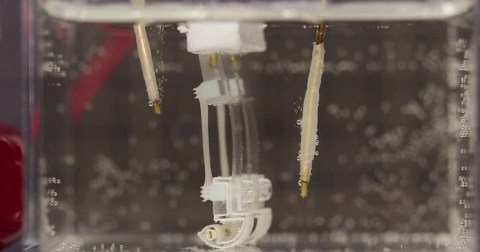After successfully integrating human cells into a robot and getting it to walk, scientists have taken a step closer to building cyborgs.
By fusing muscle tissues with synthetic materials, researchers from the University of Tokyo created the new hybrid robot, which has been dubbed a “giant leap” for cyborg robotics.
Compared to robots, human bodies are flexible, capable of fine movements and can convert energy efficiently into movement.
The new unnamed two-legged cyborg is made from silicone rubber which bends and flexes to make muscle movements – along with the help of lab-grown skeletal muscle tissues on each leg.
The robot aims to mimic human movement, but just very slowly as it does take over a minute to walk and turn.
So we don’t need to panic just yet – however, watch out as the researchers plan to improve the robot’s speed in the coming years by giving them more powerful movement through joints and thicker muscle tissues.
Muscle tissues have allowed biohybrid robots to crawl, swim and make turns, making it an essential feature for robots to avoid obstacles.
‘Research on biohybrid robots, which are a fusion of biology and mechanics, is recently attracting attention as a new field of robotics featuring biological function,’ said Dr Shoji Takeuchi, an author of the study, which was published in the journal Matter.
‘Using muscle as actuators allows us to build a compact robot and achieve efficient, silent movements with a soft touch.’
Their robot has a foam buoy top and weighted legs to help it stand straight underwater, and the researchers attached strips of lab-grown skeletal muscle tissues to the silicone rubber and each leg.
When the muscle tissue was zapped with electricity, they contracted, lifting the leg.
The heel of the leg then landed forward once the electricity left.
After alternating the electric stimulations between the left and right leg every five seconds, the robot was able to successfully walk – albeit at a snail’s pace of around 5.4mm per minute or 0.002 miles an hour.
But still, one small step for (robot) man.
The researchers even managed to make the robot turn 90 degrees to the left through the same technique, using the left leg as an anchor.
This process took a hot minute, however – a whole 62 seconds.
‘Currently, we are manually moving a pair of electrodes to apply an electric field individually to the legs, which takes time,’ said Dr Takeuchi.
‘In the future, by integrating the electrodes into the robot, we expect to increase the speed more efficiently.’
But before the researchers make the robot more human, Dr Takeuchi says the team needs to create a nutrient supply system so the living tissues survive and create a way the robot can operate in the air.
‘A cheer broke out during our regular lab meeting when we saw the robot successfully walk on the video,’ added Dr Takeuchi.
‘Though they might seem like small steps, they are, in fact, giant leaps forward for the biohybrid robots.’





